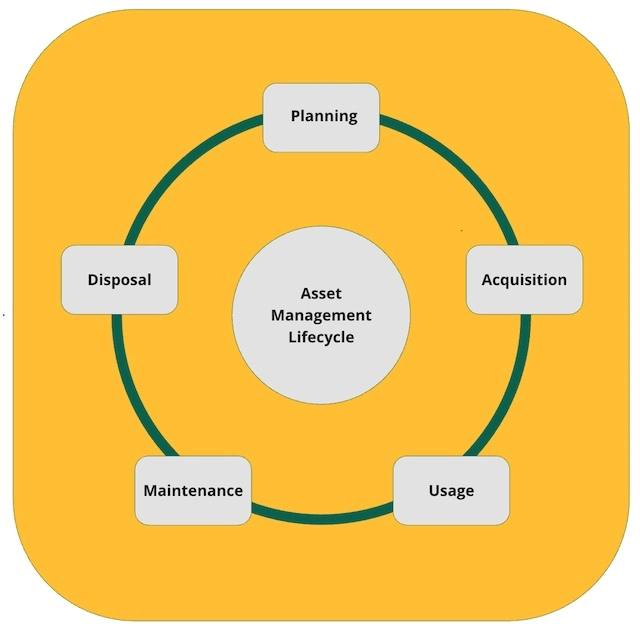

Asset Management Definition
Asset management is the practice of getting the most possible value from an asset throughout its life cycle. This means that all types of assets are viewed, from the time they enter the asset planning phase until the time they complete the asset disposal phase, through a critical lens that’s meant to maximize their monetary contribution to the company.
For instance, evaluating a fixed tangible asset, like a building during the planning phase may mean that the business questions:
- For how long will we want to do business in this location?
- Can we afford this facility?
- For what taxes and licensing costs will be we liable?
- What will it cost to keep up the facility? What extra landscaping, cleaning or other costs may arise?
- What if the expected infrastructure updates in this location do not happen?
Asset management looks not only at how the asset fits into the business from an accounting perspective, but also evaluates an asset based on what will be required to operate and maintain it, its risks, and any other asset-related activities.
What Is an Asset?
If “asset management” is about optimizing the use of assets, it’s important to clarify the definition of what an asset is. According to the dictionary, an asset is an “item of value that’s owned.” For businesses, an asset means anything that is owned by the business, from which some economic benefit is expected. This is a broad definition that covers many types of assets, ranging from investments and cash to equipment and information.
Types of Asset Management
The term “asset management” is very general. Therefore, it is logical to have more specific use cases to support different asset types or organizations within a business. The following covers just a few of these.
Financial Asset Management
Financial asset management is the most traditional of the asset management categories. It involves managing all of the financial tools used by an organization. The asset manager examines things like stocks, investments, bonds and real estate. They also look at related interest rates and debts. The purpose is to maximize financial gain and minimize any risks to the company. Sometimes, this is referred to as wealth management.
Physical Asset Management
Physical asset management oversees the optimization of tangible assets throughout the lifecycle. This would include anything you can touch and feel, such as a building, piece of equipment or raw materials. It focuses on best possible utilization of the assets through scheduling, maintenance, and disposal.
Infrastructure Asset Management
As its name implies, infrastructure asset management focuses on optimizing infrastructure – roads, waterways, utilites. Much like physical asset management, those focused on infrastructure are seeking ways to prolong the life of assets. They understand at which points the assets must be replaced and ensure overall maintenance and care of the infrastructure.
IT Asset Management (ITAM)
IT asset management focuses solely on the assets that are required to run the information technology organization of a business. It seeks to optimize the efficiency and security of hardware, data and software assets.
Public Asset Management
A public asset is one which is owned by the government. Think about assets such as school buildings, sewer systems or water treatment plants. Governments have a responsibility to ensure that public assets are used responsibly.
Public asset management is the practice that supports them in this.
Enterprise Asset Management (EAM)
“Enterprise asset management” is the oversight of operational assets. It ensures that these assets work in the most cost effective and efficient way possible. It is a bit broader in scope, including all the tools, such as computer maintenance management systems (CMMS), systems and services that are necessary for tracking, maintaining, and reporting on assets. It also extends into the scheduling of work, supply chain and environment to help avoid risks and remove operational efficiency barriers.
Digital Asset Management (DAM)
Digital assets are all of the digital creations that a company has, such as software, video, images, PDFs or design files. DAM, or digital asset management, helps companies use these more efficiently. It does this by storing them in a centralized catalog. This leads to more efficient usage and oversight.
The Benefits of Asset Management
Because asset management takes a holistic look on each asset over time, the business has information to constantly maximize the impact of assets on revenue. Benefits include:
- Improved sustainability as the asset is used in the most environmentally efficient way possible.
- Better return on investment because assets are used more effectively, giving the company more value from its investment.
- Data-driven decision making is possible because assets are tracked, measured, and improved over time. This gives a view into the current status and enables better projections for the future.
- Risk management can be improved when the status of all assets is known. This way, management can balance the operational impacts of slowdown or failure against the asset costs.
In fact, its benefits are so significant that the ISO organization is currently working on the ISO 55001 standard. This standard is to establish a framework for asset management systems. This framework will help businesses have a consistent approach to improving efficiency and effectiveness.
Types of Assets
Assets can be classified in a number of different ways, including convertability, physical existence and usage. Each of these classifications is independent from the others, so a single asset may be classified in multiple different ways.
Convertability
Convertability classifies an asset based on how quickly it may be converted to cash.
Current Assets. Current assets are things that the business expects to use within the fiscal year. These can be quickly converted to cash. These may often be refered to as liquid assets. This includes things such as bank accounts, inventory, pre-paid expenses or accounts receivable.
Non-Current or Fixed Assets. Non-current assets are things that will be owned by the business beyond the fiscal year. Their value gets used up a little at a time, and these are often called fixed assets. It includes assets like buildings, servers, vehicles, trademarks or patents.
Physical Existence
Classifying an asset based on its physical existence means determining if it has a physical form.
Tangible Asset. When an asset does have a physical form, it is known as a tangible asset. It’s something that can be touched, and it is something that could be used as collateral in obtaining loans by the business. Examples of tangible assets are furniture, computers, buildings, or machinery.
Intangible Asset. In converse, intangible assets do not have a physical form, but they can still provide value to the business. This includes assets like patents, trademarks, permits or liscenses.
Usage
Dividing assets by usage means considering if the asset is part of getting the business’ core job done. Alternatively, it could be something that can generate revenue beyond the scope of the core business.
Operational. Operational assets are those which directly contribute to driving revenue through the core business, such as patents, manufacturing facilities or inventory.
Non-Operational. Non-operational assets may help drive revenue, but are not part of the core operations. This includes assets like interest earned, short-term investments or property (Although, in some cases, property may be considered operational instead.)
Asset Lifecycle
In addition to understanding what assets are, understanding the asset lifecycle is a key part of asset management. After all, it’s important to recognize the impact of an asset from the moment it is considered through investment to its eventual uselessness.
Depending upon the specific asset, the terms used to identify phases of the asset lifecycle may be slightly different. However, they generally follow the same flow.

Asset Management Lifecycle
Asset Planning
During the asset planning phase, the company recognizes that it has a need and begins to evaluate solutions. Overall costs are evaluated. This includes the cost to obtain the asset. It also includes those expected for maintaining and disposing of the asset later in its lifecycle. This helps the company make investment decisions.
Asset Acquisition
Once the best solution has been determined, it is sourced and obtained. The investment is made. Typically, it’s at this stage of the lifecycle when a business decides if it’s better to build a solution themselves or purchase an existing solution – with or without help from a contractor.
Asset Deployment and Usage
Sometimes this next phase is broken into two separate items. The asset deployment phase is when the asset is first introduced into the environment. It may include considerations about training, asset tagging or safety awareness.
From there, the asset is put into use and can start driving revenue. During this phase, several asset-related tasks are done. These tasks include additional training, updating software licences, adapting schedules, cleaning and completing virus scanning.
Asset Maintenance
Once in use, the asset may undergo updates and modifications that help to streamline its usage and inspire efficiency.
Asset Disposal
Eventually, the asset reaches the end of its useful life. At this point, options for recycling, reselling or simply disposing of the asset must be considered.
What Is an Asset Management System?
As asset management system is the combination of processes and software that a company (or government in the event of public asset management) uses to optimize its use of assets.
It helps the business in multiple ways by:
- Keeping track of an asset, including where it is located and how it is being used.
- Tracking contracts and licensing information related to the assets.
- Ensuring maintenance happens on time and that assets are up-and-running as expected.
- Reporting on the state and usage of assets.
- Integrating with service management software ensures that related events, incidents, and requests are dealt with efficiently. This prevents any interruption to operations.
As an example, OTRS is often used by IT teams that want to more efficiently oversee their IT assets by using IT asset management software.
By using asset management, companies are able to achieve their financial goals and make comprehensive long term decisions that support corporate sustainability. Learn more about service management software that support asset management today.
Categories
- About OTRS Group (21)
- Automation (3)
- Corporate Security (26)
- Customer Service (30)
- Developing a Corporate Culture (12)
- Digital Transformation (54)
- General (86)
- ITSM (36)
- Leadership (22)
- OTRS in Action (8)
- Processes (5)
- Using OTRS (15)
